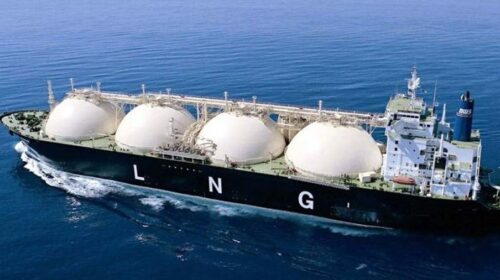Russia’s dramatic invasion of Ukraine has given liquefied natural gas, or LNG, the spotlight like never before, as several European countries scramble to replace their main natural gas supplier.
It is also helping emphasize the benefit that LNG export terminals in Mexico could provide for natural gas, especially in Asia.
The idea of exporting LNG from Mexico has been gaining traction in recent years. It has become more attractive as some LNG originally intended to meet its demand is now being rerouted to Germany and other Russian clients.
Even though it does not produce much of its own natural gas, it is able to access the low-cost natural gas from the Permian basin via a huge pipeline build-up in the last decade. While the continental U.S. began exporting LNG in 2016 via Cheniere’s Sabine Pass in Louisiana, additional export terminals on the West Coast have proved difficult to permit.
At the same time, Mexico, which once expected LNG imports to meet its growing energy demands – and built the terminals to do so – has since replaced it with piped natural gas from Texas. Two separate companies have used this change as the basis for developing LNG exporting sites that could benefit from access to the Permian basin and a clear shot across the ocean to Asian markets.
MORE FOR YOU
Here’s The List Of 317 Wind Energy Rejections The Sierra Club Doesn’t Want You To See
Revisiting The Blame For High Gas Prices
Why Do ‘Fracking’ Opponents Ignore Its Moral Benefits?
The first, Sempra, a California energy infrastructure company and its Mexican affiliate Ienova, has one LNG export project underway in Mexico near Ensenada that is scheduled to start by the end of 2024. The company recently announced plans for a second in Topolobampo, Sinaloa. It has established agreements with Mexico’s state-owned Federal Electricity Commission, or CFE, to use CFE’s pipeline network to Texas, in exchange for helping it provide much-needed natural gas to Baja California.
In terms of pricing, shipping to Asia from the Pacific Coast is attractive, as it skips the need to cross the Panama Canal, shortening the travel time by about half, relative to the Gulf Coast. The savings translates to about $2/MMBtu in shipping-associated costs, according to analysis by UH Energy. (The cost savings are based on bunker fuel savings and a four-day reduction in voyage time, as well as avoiding Panama Canal passage costs.)
The Topolobampo project still faces some permitting hurdles from both the Mexican government and the U.S. Dept. of Energy, but Sempra has expressed confidence that it will be able to do so, based on its relationship with the CFE and its track record with the Ensenada project.
“The environmental regulatory climate in the US is very strict,” said Miriam Grunstein, a Mexican energy lawyer who has provided counsel on energy regulations to Pemex and to Mexico’s Senate and Federal Electricity Commission. “Our environmental leniency in Mexico has a lot to do with the LNG development.”
Another LNG project is in the process of being developed in Sonora by Mexico Pacific Limited, under leadership based in Texas. It has spent the last couple of years securing key environmental permits in Mexico and the clientele for its products.
Doug Shanda, chief executive officer of Mexico Pacific, says the company has secured the needed financing, and is currently finalizing the process of contracts with clients and engineering before it finalizes the move forward with a final investment decision.
“This project has great fundamentals,” Shanda said, citing its proximity to cheap Texas gas and access to hungry Asian markets. “We needed that last bit of equity financing, and getting that has created a lot of confidence in the project.”
The Mexico Pacific project still appears to have some challenges ahead in securing enough pipeline connectivity to bring in the natural gas, according to Bethel King, the senior director of market analysis for RBAC, Inc., an energy markets simulation systems firm.
“They are being very rose-colored glasses about supply,” King said. “I think it is going to be a little tougher, particularly in its planned second phase. But it will certainly be a welcome challenge to US producers and US and Mexican midstream developers.“
The fact that it has essentially all the necessary permits in place is tremendous progress, especially at a time when other energy projects in Mexico have stalled for want of permitting.
None of this is to say that setting up new LNG export terminals in Mexico is inherently easy, given the current administration’s overall swing towards resource nationalism at the expense of foreign investors. Several credit agencies have downgraded Mexico’s sovereign and institutional ratings in part because of its hostility towards energy investment in oil and renewable power.
There are also the practical considerations.
On Mexico’s Atlantic coast, for example, establishing sufficient natural gas pipelines for Mexico’s domestic demand has been a big challenge. Organized crime and social resistance to pipelines have deterred onshore development, although the new marine Sur de Texas-Tuxpan pipeline has circumvented these problems.
Even so, turning Mexico’s existing LNG import facilities on its East Coast to export sites doesn’t make financial sense. They would only compete, badly, with the already-functioning terminals on the U.S. Gulf Coast, all of which have better access to gas producers and pipeline infrastructure already in place.
“There has never been an LNG export project proposed on Mexico’s East coast, nor in our estimation is one ever likely to be,” said Alex Munton, principal analyst for Americas LNG at Wood MacKenzie.
Yet the Pacific Coast projects feel strangely prescient, moving forward when Europe is thinking much more seriously about how to replace Russian gas, and gas that had once been sent to Asia is meeting the immediate demand.
It’s another indicator of this new era for LNG, which until last year had been thought of as being in extreme oversupply. Suddenly, governments and power companies are starting to think about energy in terms of the security it provides, and its potential to swing the balance in global economics and politics. Mexican LNG will not directly ease the upswing in European demand – it is not economic to ship it through the Panama Canal at this time – but it could ease the growing demand in Asia.
And while the LNG projects move forward on Mexico’s Pacific Coast, similar projects in the U.S. are facing roadblocks. Jordan Cove in Oregon, for example, has had years of fighting over state and local permits, and now is on hold, possibly permanently.
Options like Mexico and Canada are giving the U.S. ability to find additional markets for its excess natural gas, even as the Biden administration is encouraging a rapid 50% reduction from 2005 fossil fuel usage by 2030.
To bridge the seeming contradiction, the administration has mostly focused on the argument that natural gas exports help move the world away from a dirtier coal alternative. But as countries throughout northern Europe see all too clearly right now, keeping LNG in the mix during the energy transition provides options that – while not as carbon free as renewable power – are both cleaner and more politically palatable.
Our global economies are just at the beginning of taking on the complexity, the politics and the cost of a multi-trillion-dollar energy transition. If ensuring this kind of flexibility is in the mix is important now, it will be all the more so in the years to come.
Emily Pickrell is a veteran energy reporter, with more than 12 years of experience covering everything from oil fields to industrial water policy to the latest on Mexican climate change laws. Emily has reported on energy issues from around the U.S., Mexico and the United Kingdom. Prior to journalism, Emily worked as a policy analyst for the U.S. Government Accountability Office and as an auditor for the international aid organization, CARE.
UH Energy is the University of Houston’s hub for energy education, research and technology incubation, working to shape the energy future and forge new business approaches in the energy industry.





